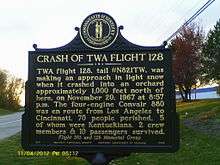TWA Flight 128
|
A Convair 880 of TWA similar to the crash aircraft | |
| Accident summary | |
|---|---|
| Date | 20 November 1967 |
| Summary | Controlled flight into terrain[1] |
| Site |
Constance, Kentucky 39°5′3.73″N 84°40′11.99″W / 39.0843694°N 84.6699972°WCoordinates: 39°5′3.73″N 84°40′11.99″W / 39.0843694°N 84.6699972°W |
| Passengers | 75 |
| Crew | 7 |
| Fatalities | 70 |
| Survivors | 12 (10 passengers and 2 crew members) |
| Aircraft type | Convair 880 |
| Operator | Trans World Airlines |
| Registration | N821TW |
TWA Flight 128 was a regularly scheduled Trans World Airlines passenger flight from Los Angeles to Boston, with intermediate stops in Cincinnati and Pittsburgh. On November 20, 1967, Flight 128 crashed on final approach to Greater Cincinnati Airport; 70 of the 82 people aboard the Convair 880 were killed.[1]:1
Aircraft
On November 20, 1967, TWA Flight 128 was operated using a Convair 880 (registration number N821TW).[1]:1 It was the sixth loss of a Convair 880 and at the time the worst accident involving a Convair 880, and 12th worst airline disaster in the U.S. This accident is currently the second worst involving a Convair 880, the 38th worst accident in the United States, and the worst in Kentucky state history. The aircraft was the third TWA plane lost in 1967, the first being TWA Flight 553 and the second, only fourteen days before Flight 128, TWA Flight 159, also at Cincinnati.
Crash
Flight 128 departed Los Angeles at 17:37 Eastern Standard Time and operated to Cincinnati without incident.[1]:2–4 The flight was initially scheduled to make an Instrument Landing System approach to Greater Cincinnati Airport's runway 18. The outer marker beacon for runway 18 was operational, but the middle marker beacon, glide slope, and runway approach lights were inoperative.[1]:9 Under these conditions, proper procedure would be to maintain the minimum approach altitude of 1,290 feet above mean sea level until the pilots made visual contact with the runway.[1]:9–10
At 20:56, Flight 128 reported passing the outer marker, and was cleared to land.[1]:2 The flight crew then initiated their descent and began performing their final landing checklist.[1]:2 While on final approach, the aircraft descended to an elevation of 875 feet, where it first struck trees in a spot 9,357 feet short of runway 18 and 429 feet right of the runway's extended centerline.[1]:2 The first impact was described by a survivor as like a hard landing; this was followed by a series of hard bumps and the airplane's final impact.[1]:2 The aircraft's final position was in a wooded area 6,878 feet short of the runway, where it disintegrated and was enveloped in flames.[1]:2
Of the 82 people on board the aircraft, 60 were killed immediately and another 10 died in the days following the crash.[1]:16 Twelve people (two crew members and 10 passengers) survived with nonfatal injuries.[1]:3 One of the surviving passengers reported that the plane broke apart in front of him, he stepped out and ran from the wreckage shortly before it exploded.[2]
Surviving passengers included a 15-month-old baby, 2-year old Eileen Haile and 5-year old Chris Haile.
Aftermath
The National Transportation Safety Board investigated the accident.[1]:1 NTSB investigators determined the probable cause of the accident to be crew error, in attempting visual no-glide-slope approach at night during deteriorating weather conditions without adequate altimeter cross-reference.[1]:38
The governor of Ohio, Jim Rhodes, requested runway 18 be closed, but this was never seriously considered, as the airport is in Kentucky.

See also
References
- NTSB Report # AAR69-05
- NTSB brief DCA68A0002
- Photo of Aircraft
- Time magazine article December 1, 1967
- TWA Flight 128 Home Page
